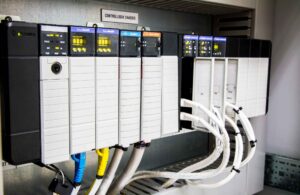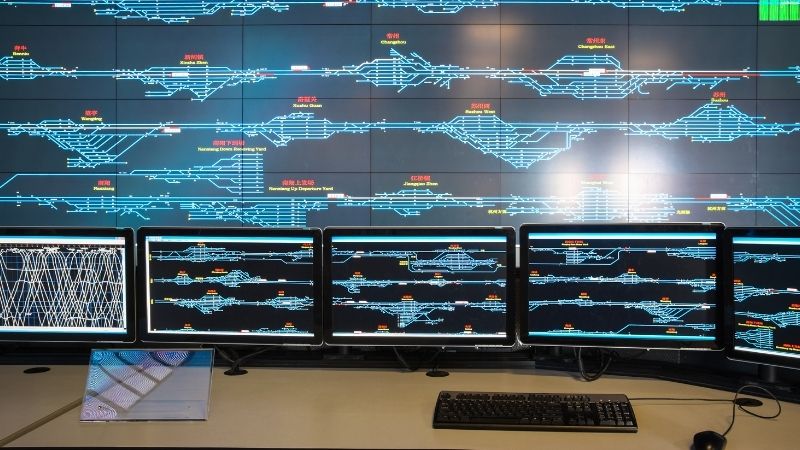HMI vs. SCADA: guida essenziale all'automazione industriale
Questo blog approfondisce gli aspetti fondamentali di Interfaccia uomo-macchina e sistemi SCADA, i loro componenti, le applicazioni e i vantaggi che apportano alle industrie moderne.
Sommario
Cos'è SCADA e come funziona?
SCADA, abbreviazione di Supervisory Control and Data Acquisition, è un sistema centralizzato progettato per monitorare e controllare i processi industriali. Combinando hardware e software, SCADA consente alle industrie di raccogliere dati in tempo reale da sensori, trasmetterli ai sistemi di controllo e fornire informazioni utili.
Caratteristiche principali dei sistemi SCADA:
- Raccolta dati: Il sistema SCADA raccoglie le informazioni dai sensori e le trasmette a un hub di controllo centrale.
- Monitoraggio e avvisi: Rileva deviazioni o guasti e invia avvisi in tempo reale.
- Automazione: Il sistema automatizza le attività di routine, riducendo la necessità di interventi manuali.
- Telecomando: Gli operatori possono controllare le apparecchiature e i processi da una postazione centralizzata o remota.
Settori che sfruttano SCADA:
I sistemi SCADA trovano applicazione in vari settori, tra cui:
- Petrolio e gas
- Trattamento dell'acqua
- Produzione
- Distribuzione di energia
- Trasporti
Comprendere l'HMI: il gateway dell'operatore
L'interfaccia uomo-macchina (HMI) funge da mezzo visivo e interattivo tra operatori e sistemi di controllo industriale. Dai touchscreen ai dispositivi mobili, i sistemi HMI consentono agli operatori di monitorare e controllare i processi senza soluzione di continuità.
Componenti dei sistemi HMI:
- Hardware: Include dispositivi di input (touchscreen, pulsanti) e dispositivi di output (monitor, indicatori).
- Software: Fornisce un'interfaccia utente per il controllo dei processi e l'analisi dei dati.
- Protocolli di comunicazione: Facilita lo scambio di dati tra macchine e operatori tramite reti Modbus, Ethernet/IP o wireless.
Applicazioni dei sistemi HMI:
- Monitoraggio delle linee di produzione nella produzione
- Controllo del flusso di energia nelle reti intelligenti
- Gestione dei sistemi HVAC negli edifici intelligenti
- Supervisione dei processi di trattamento delle acque reflue
La relazione tra HMI e SCADA
Sebbene HMI e SCADA siano strettamente collegati, nell'automazione industriale svolgono funzioni distinte:
- HMI come componente di SCADA: L'HMI fornisce un'interfaccia intuitiva per interagire con il sistema SCADA.
- SCADA come sistema centrale: SCADA gestisce e controlla operazioni complesse, mentre HMI funge da strumento di visualizzazione per l'operatore.
- Insieme, garantiscono un flusso di dati fluido, informazioni fruibili e un controllo efficiente dei processi.
Vantaggi dell'integrazione di HMI e SCADA
L'integrazione di HMI e SCADA offre vantaggi senza pari all'automazione industriale:
- Efficienza migliorata: Semplifica le operazioni con monitoraggio in tempo reale e analisi dei dati.
- Maggiore sicurezza: Avvisa gli operatori dei potenziali pericoli, riducendo i rischi.
- Ottimizzazione dei costi: L'automazione riduce al minimo i costi operativi e i tempi di fermo.
- Scalabilità: Facilmente adattabile alle crescenti esigenze industriali.
- Accessibilità remota: Consente agli operatori di monitorare i sistemi praticamente da qualsiasi luogo.
Componenti principali dei sistemi SCADA
Per funzionare in modo efficace, i sistemi SCADA si basano su quattro componenti chiave:
- Sensori: Misurare parametri quali temperatura, pressione e portata.
- Unità di conversione dei dati: Utilizzo PLC e RTU per elaborare i dati grezzi dei sensori.
- Dashboard HMI: Presentare i dati in un formato comprensibile per gli operatori.
- Reti di comunicazione: Collegare i componenti nell'intera struttura utilizzando metodi cablati o wireless.
Tendenze future in HMI e SCADA
Con l'evoluzione dei settori industriali, i sistemi HMI e SCADA stanno adottando tecnologie avanzate per migliorare la funzionalità:
- Integrazione IoT: Collegamento di dispositivi per una raccolta e un'analisi dei dati più intelligenti.
- Intelligenza artificiale e apprendimento automatico: Analisi predittiva per la manutenzione e l'ottimizzazione dei processi.
- Cloud Computing: Archiviazione centralizzata dei dati e accessibilità remota.
- Interfacce utente migliorate: Design HMI più intuitivi e personalizzabili per una migliore esperienza utente.
Dai vita ai tuoi progetti con i nuovi HMI originali Omron, Mitsubishi e Schneider, disponibili subito in magazzino!
Conclusione
I sistemi HMI e SCADA sono strumenti indispensabili nell'automazione industriale, che lavorano in armonia per monitorare, controllare e ottimizzare processi complessi. Mentre SCADA fornisce una piattaforma centralizzata per la gestione delle operazioni, HMI colma il divario tra macchine e operatori umani. Insieme, queste tecnologie consentono alle industrie di ottenere maggiore efficienza, sicurezza e produttività.
Se hai bisogno di un fornitore HMI, contatta Kwoco. Offriamo HMI nuovi di zecca e originali da Profago, Omron, E Mitsubishi, pronto per la spedizione in tutto il mondo. Qualità affidabile, marchi fidati e servizio globale ti aspettano!
Contattaci
Basta compilare il tuo nome, indirizzo email e una breve descrizione della tua richiesta in questo modulo. Ti contatteremo entro 24 ore.
Categoria di prodotto
Prodotti in saldo
Potresti trovare interessanti anche questi argomenti

Cos'è un timer in un PLC e come funziona?
Cos'è un timer in PLC e come funziona? Nel mondo dell'automazione industriale, il tempo è tutto.

Guida alla selezione di Allen-Bradley PanelView: scegli l'HMI giusto
Stai cercando di selezionare il PanelView Allen-Bradley più adatto alle tue esigenze di automazione industriale? Questa guida completa alla selezione ti guiderà attraverso tutto ciò che devi sapere su PanelView Plus 7, PanelView 800 e altri terminali grafici della famiglia Allen-Bradley. Che tu stia aggiornando il tuo sistema esistente o iniziando da zero, questa guida ti aiuterà a prendere una decisione informata.

Allen-Bradley vs ABB: qual è la scelta migliore per l'automazione industriale?
Nel mondo in rapida evoluzione dell'automazione industriale, due nomi spesso spiccano: Allen-Bradley e ABB. Entrambi sono giganti del settore, che offrono soluzioni all'avanguardia come PLC, VFD e controller. Ma sono la stessa cosa? Questo articolo approfondisce le complessità di questi due marchi, confrontando le loro offerte per aiutarti a prendere decisioni informate per i tuoi sistemi di controllo.






